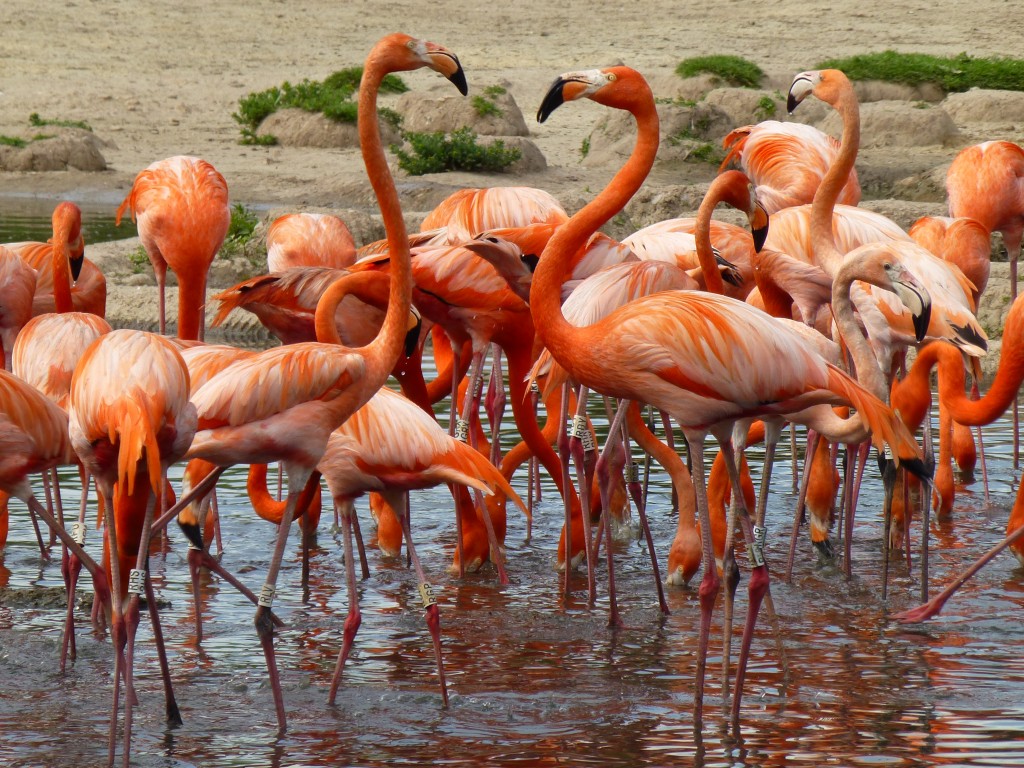Hundreds of happy flamingos
Having kept flamingos for over 50 years, WWT knows a fair amount about keeping them "in the pink" and in the best health. It is important that the birds are given a stimulating and interesting environment so that they behaviour naturally and life long, healthy lives. In this post, I thought I would explain some of the ways in which WWT Slimbridge flamingos are kept so that they always look their best. Whilst ensuring that the flamingos have an opportunity to try and breed each year is obviously one way that birds provide a wonderful display of natural behaviour, the avics also have other tricks up their collective sleeves that they use to entertain the flamingos.
[yframe url='http://www.youtube.com/watch?v=J4abODJYS6Y&list=UUp41rC1pWyYfO5RLXe6VUMg']
Flamingos love to filter and forage in the water and whilst the pools at Slimbridge provide them with lots of opportunities to do this, it can be a bit of treat for the birds if they are given extra things to "find" whilst they are filtering away. In the video clip above the flock of greater flamingos have been provided with duckweed, which grows in large blooms over the summer, and this keeps the birds busy for many hours. Duckweed is a tasty treat and encourages the flamingos to forage in all of the corners of their exhibit.
[yframe url='http://www.youtube.com/watch?v=KFqXc4ccUA0&list=UUp41rC1pWyYfO5RLXe6VUMg']
As well as duckweed, other naturally occurring microscopic animals and plants that grow in the flamingos' pools help to keep them busy. The lesser flamingos in the video above are filtering the water for such tiny goodies. Flamingos will spend many hours searching for algae and small aquatic invertebrates (daphnia, blood worms and such like to those that might have seen these sorts of insects before) that the unique bristly apparatus in their beaks are able to sieve out of the water. Flamingos love sunshine and you'll notice that the enclosures at WWT Slimbridge are open to as much sunshine as possible. Sunshine warms the water in the pools and encourages all of these tasty insects and plants to grow, allowing the flamingos to forage until their hearts are content.
[yframe url='http://www.youtube.com/watch?v=CNPskpW_9m0&list=UUp41rC1pWyYfO5RLXe6VUMg']
As each of the species of flamingo feeds in a different way it is important to allow them the space to do this properly. So as you can see in the short clip of Mr James filtering in the water, this species of flamingo likes to spread out from other birds and use very still water where he can float his beak in just the top few centimetres. Whilst there may be only one of him, his wellbeing is still very important.
And the greater flamingos in the clip below do a very similar behaviour but they place their bills much lower in the water. As they have much rougher bristles in their beak compared to the James' flamingo, they can muck around in the silt and mud closer to the floor of the pool. But still note how still they are and how they use a wide area to feed in, hence the reason why such big pools are good for the birds.
[yframe url='http://www.youtube.com/watch?v=pD7DyvjQuGg&list=UUp41rC1pWyYfO5RLXe6VUMg']
So a combination of lots of water, plenty of sunshine (if we get that over a summer!) and some buckets of duckweed can provide for hours of flamingo amusement. Catch the Caribbean flamingos at the end of the day, especially on a long summer's evening (bring on June next year already...) and you'll see them making a fine sight all over the front of their pool. Lovely stuff.
[yframe url='http://www.youtube.com/watch?v=BgbGkKO-DVM&list=UUp41rC1pWyYfO5RLXe6VUMg']




